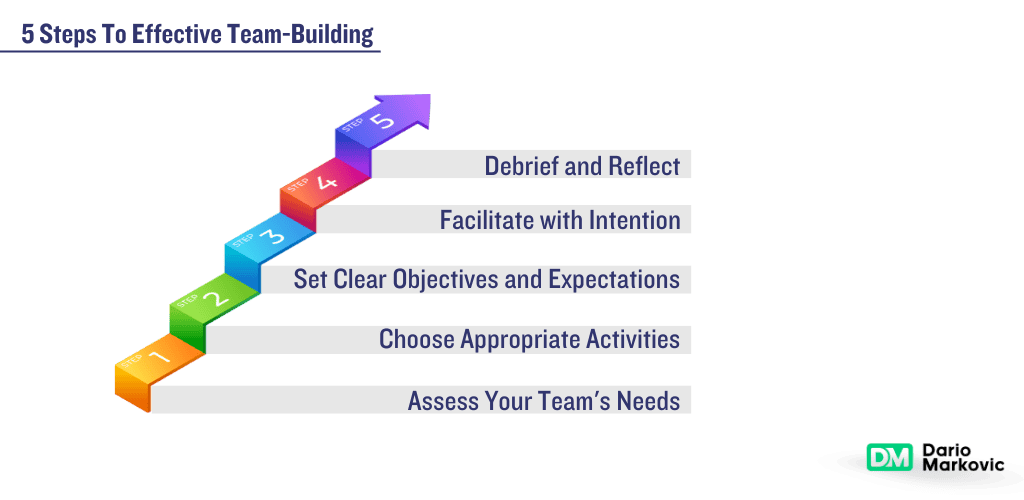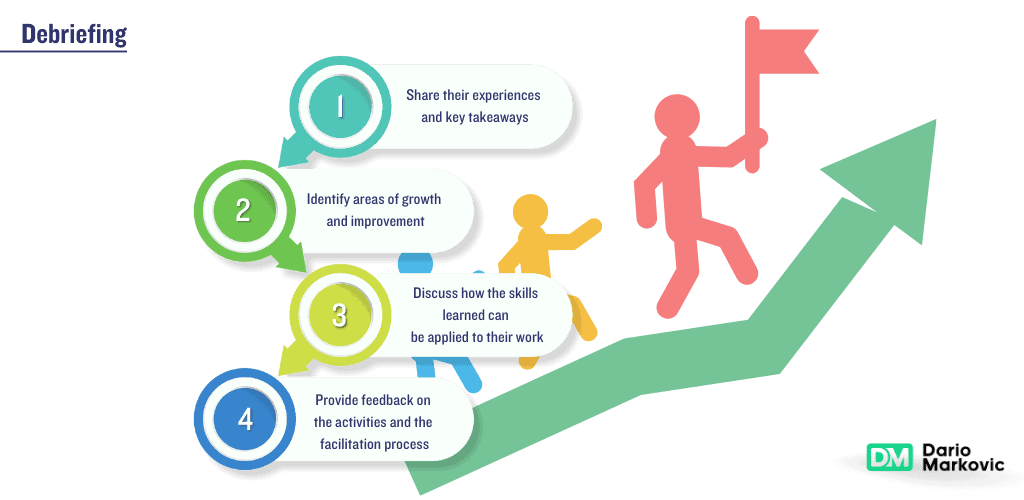Are you looking to foster stronger connections and a more cohesive team dynamic within your small group? Practical team-building activities for small groups can be the key to unlocking your group’s full potential.
In this blog post, we’ll explore various team-building activities for small groups that can help your team work better together, communicate more effectively, and achieve their goals more quickly.
Whether leading a small business, managing a project team, or facilitating a community group, the right team-building exercises can make all the difference. By the end of this guide, you’ll have a toolbox of strategies to create a more collaborative, engaged, and high-performing small group.
What are Team Building Activities for Small Groups?
Team-building activities for small groups are structured exercises and games designed to improve communication, collaboration, problem-solving, and interpersonal skills within a tight-knit team.
These activities can range from quick icebreakers to more involved group challenges, all designed to strengthen the bonds between team members and foster a stronger sense of unity.
Reasons You Need to Know Team Building Activities for Small Groups
Improved communication and conflict resolution: Team building activities promote open dialogue, active listening, and constructive conflict management.

Enhanced collaboration and problem-solving: Group exercises encourage creative thinking, task coordination, and a shared sense of purpose.
Stronger team cohesion and trust: These activities help team members get to know each other better, build interpersonal connections, and develop a greater camaraderie.

Increased productivity and morale: Well-executed team building can boost employee engagement, motivation, and overall team performance.
By incorporating team-building activities for small groups into your routine, you can unlock your team’s full potential and create a more positive, productive, and enjoyable work environment.
Step-by-Step Instructions for Effective Team Building Activities for Small Groups
Designing impactful team-building activities for small groups requires a thoughtful approach. Here’s a step-by-step guide to help you get started:

Let’s dive into each step in more detail:
Step 1: Assess Your Team's Needs
Before selecting team-building activities, take the time to understand your small group’s unique dynamics and challenges. Consider factors such as:
The team’s communication style
The level of trust and cohesion
Any ongoing conflicts or areas of improvement
The team’s strengths and weaknesses

The team’s goals and desired outcomes
Tailoring the activities to your team’s specific needs will increase your chances of achieving meaningful and lasting results.
Step 2: Choose Appropriate Activities
With your team’s needs in mind, select various team-building activities for small groups that address your key focus areas. Consider a mix of:
Icebreakers to help team members get to know each other better
Problem-solving challenges that require collaboration
Communication exercises that encourage active listening and feedback
Trust-building activities that foster vulnerability and support

Fun, lighthearted games that promote bonding and camaraderie
The best team-building activities are those that balance enjoyment and learning.
Step 3: Set Clear Objectives and Expectations
Before launching any team-building activities, take the time to communicate the purpose and desired outcomes. Explain how the activities align with the team’s goals and how the skills developed during the exercises can be applied back on the job.
Establish ground rules, time frames, and any necessary resources or materials. This will help ensure your team understands the intent and engages fully in the experience.
Step 4: Facilitate with Intention
When facilitating team-building activities for small groups, approach each exercise thoughtfully and carefully. Set the tone with positive energy, encourage active participation, and provide clear instructions. Be ready to adapt and troubleshoot to ensure everyone feels comfortable and engaged.
Observe the team’s dynamics throughout the activities and provide constructive feedback. Offer opportunities for reflection and discussion, allowing team members to share their insights and learnings.
Step 5: Debrief and Reflect
After completing the team-building activities, take the time to debrief with your small group. This is a crucial step in the process, as it allows team members to:

Reflecting on the team-building experience can reinforce the lessons learned and ensure that the benefits extend beyond the initial session.
Critical Considerations for Successfully Implementing Team Building Activities for Small Groups
When incorporating team-building activities for small groups into your routine, keep the following key considerations in mind:
Tailor to Your Team’s Unique Needs: As mentioned earlier, select activities that address your small group’s specific challenges and goals. Avoid a one-size-fits-all approach.
Create a Safe and Inclusive Environment: Ensure all team members feel comfortable, respected, and empowered to participate. Address any concerns or hesitations proactively.
Foster Ongoing Engagement: Team building shouldn’t be a one-time event. Integrate these activities into your regular team meetings or schedule dedicated team-building sessions regularly.
Measure and Evaluate Impact: Track the progress and effectiveness of your team-building efforts by gathering feedback, observing changes in team dynamics, and measuring relevant performance metrics.

Continuously Adapt and Iterate: Be open to adjusting your approach based on the team’s evolving needs and the lessons learned from each team-building experience.
By considering these fundamental considerations, you can maximize the impact of team-building activities for small groups and create a more cohesive, high-performing team.
Taking it to the Next Level: Enhancing Team Building Activities for Small Groups
To take your team-building activities for small groups to the next level, consider incorporating the following strategies:
- Incorporate Experiential Learning: Engage your team in hands-on, immersive activities that challenge them to apply problem-solving, communication, and leadership skills in real time.
- Leverage Technology and Digital Tools: Explore virtual team-building platforms, online collaboration tools, and interactive games to enhance the team-building experience, especially for remote or hybrid teams.
- Involve External Facilitators or Experts: Bringing in experienced team-building facilitators or subject matter experts can infuse your program with fresh perspectives and specialized expertise.
- Align with Organizational Goals: Ensure your team-building activities align strategically with your company’s objectives, culture, and values.
- Foster Continuous Feedback and Improvement: Encourage ongoing feedback from team members and consistently evaluate the effectiveness of your team-building initiatives to drive continuous improvement.
By implementing these next-level strategies, you can elevate your team-building activities for small groups and create a transformative experience that empowers your team to achieve new heights of success.
Alternatives to Team Building Activities for Small Groups
While team-building activities for small groups are a highly effective way to foster team cohesion and productivity, they are not the only approach. Here are some alternative strategies to consider:
- Mentorship and Coaching Programs: Pairing team members with experienced mentors or coaches can promote individual growth, knowledge-sharing, and collaborative problem-solving.
- Shared Learning and Development: Organizing group training sessions, workshops, or lunch-and-learn events can encourage shared learning and interdepartmental collaboration.
- Social and Recreational Activities: Organizing team outings, celebrations, or recreational activities can help team members bond in a more casual, enjoyable setting.
- Collaborative Project Work: Assigning cross-functional projects that require team members to work together towards a common goal can strengthen teamwork and communication.
- Peer Feedback and Recognition: Implementing a structured peer feedback system and recognition program can foster a culture of mutual support and appreciation.
The key is to find a balanced approach that incorporates a variety of team-building strategies to meet your small group’s unique needs and preferences.
Building Stronger Bonds: Team Building Activities for Small Groups
Importance of Work Culture and Community:
Over 80% of employers and employees believe creating a sense of community at work is essential. This sense of community contributes to employee satisfaction, engagement, and productivity.
Small businesses, in particular, tend to prioritize relationships, with 66% actively engaging in team-building activities such as celebrating birthdays, holidays, and milestones together.
Remote Work and Virtual Team Building:
By the end of 2023, approximately 25% of all professionals in North America are expected to work remotely. As remote work becomes more prevalent, team-building activities need to adapt accordingly.
Virtual team-building activities have gained prominence. These include starting meetings with energizers, fun games, and other interactive elements to maintain team cohesion and morale.
Digital Tools and Collaboration:
The use of collaboration tools has risen significantly, with a 44% increase over the past two years. These tools facilitate communication, project management, and virtual team bonding.
By 2024, virtual meetings will replace 35% of in-person meetings. Asynchronous communication tools and video conferencing platforms are vital in bridging the gap for remote teams.
Challenges and Adaptation:
Approximately 41% of workers find adapting to their company’s culture challenging during remote work. Team building activities can help bridge this gap and create a shared sense of purpose.
Interestingly, 52% of workers believe that company culture is as influential in remote work as in the office. This emphasizes the need for intentional efforts to maintain a positive work culture, even in virtual settings.
Frequency of Team Building Activities:
Surprisingly, only 33% of companies hold simple team-building activities like virtual coffee breaks or tea sessions. Increasing the frequency of such activities can significantly impact team morale and cohesion.
Striking a balance between work-related tasks and team bonding moments is crucial. Regular team-building sessions contribute to a more supportive work environment.
Leadership Perspective:
A survey found that 55% of leaders believe that team culture would improve if their company invested more in team-building initiatives. Investing in team-building initiatives can lead to better collaboration and employee satisfaction.
Wrapping Up and My Experience with Team-Building Activities for Small Groups
Practical team-building activities for small groups can be a powerful tool for creating a more cohesive, collaborative, and high-performing team. By carefully assessing your team’s needs, selecting appropriate activities, and facilitating with intention, you can unlock your small group’s full potential and take your team’s success to new heights.
As an experienced team leader and facilitator, I’ve witnessed firsthand the transformative impact of well-executed team-building exercises. From fostering stronger interpersonal connections to improving communication and problem-solving skills, these activities have been instrumental in helping the teams I’ve worked with achieve their goals and thrive in their respective environments.
You should experiment with the strategies outlined in this blog post and find the team-building activities for small groups that resonate most with your team. With creativity and dedication, you can build a highly productive team that enjoys working together.
FAQ
Team-building activities for small groups are structured exercises and games designed to improve communication, collaboration, problem-solving, and interpersonal skills within a tight-knit team. These activities foster stronger bonds between team members and create a sense of unity.
- Improved Communication and Conflict Resolution: Team building promotes open dialogue, active listening, and constructive conflict management.
- Enhanced Collaboration and Problem-Solving: Group exercises encourage creative thinking, task coordination, and a shared sense of purpose.
- Stronger Team Cohesion and Trust: These activities help team members get to know each other better, build connections, and develop camaraderie.
Increased Productivity and Morale: Well-executed team building boosts employee engagement and performance.
Follow these steps:
- Assess Your Team’s Needs: Understand your group’s dynamics, communication style, strengths, and weaknesses.
- Choose Appropriate Activities: Select icebreakers, problem-solving challenges, communication exercises, trust-building activities, and fun games.
- Set Clear Objectives and Expectations: Communicate the activities’ purpose, outcomes, and relevance.
- Facilitate with Intention: Ensure everyone participates and understands the intent.
- Debrief and Reflect: Discuss what was learned and how it applies to real-world situations
Facilitation sets the tone for the activity. Your role as a facilitator is to guide the process, create a safe environment, and encourage active participation. Effective facilitation ensures that team members feel engaged, supported, and motivated.
- Set the Tone: Begin with positive energy. Smile, make eye contact, and use encouraging language.
- Clear Instructions: Provide precise instructions for the activity. Explain its purpose, rules, and desired outcomes.
- Adaptability: Be flexible. Adjust if things don’t go as planned.
- Observe Dynamics: Pay attention to how team members interact. Encourage quieter voices and manage dominant personalities.
- Feedback: Offer constructive feedback during and after activities.
- Reflection: Encourage discussion and reflection on the experience.
Debriefing allows teams to process their experiences. Here are some questions to consider:
- What surprised you during the activity?
- How did you feel during the process?
- What did you learn about yourself and your team members?
- How can you apply these insights to your work?
- Create a Safe Space: Ensure team members feel comfortable sharing their thoughts.
- Be Timely: Debrief soon after the activity while memories are fresh.
- Encourage Honesty: Invite open dialogue and authentic reflections.
- Focus on Learning: Emphasize lessons learned and growth opportunities.
Here are a few engaging activities:
- Empathy Avenue: Discuss diverse perspectives using prompts.
- Feedback Formula: Practice giving and receiving feedback.
Role-Play Relay: Act out workplace scenarios with empathy and clear communication.



